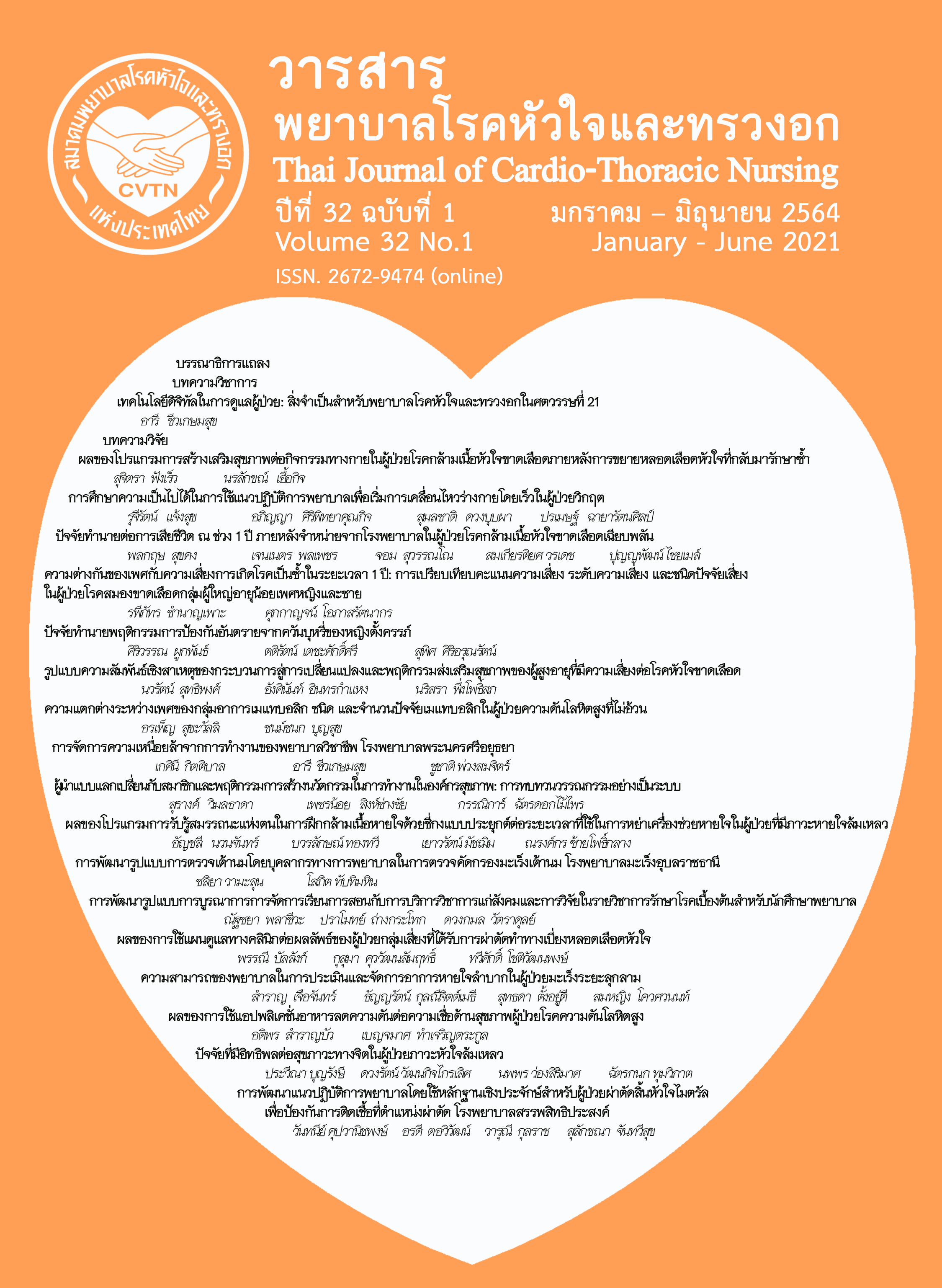การพัฒนารูปแบบการบูรณาการการจัดการเรียนการสอนกับการบริการวิชาการแก่สังคมและการวิจัยในรายวิชาการรักษาโรคเบื้องต้นสำหรับนักศึกษาพยาบาล
คำสำคัญ:
การจัดการเรียนการสอนกับการบริการวิชาการแก่สังคมและการวิจัย, การบูรณาการ, นักศึกษาพยาบาล, การรักษาโรคเบื้องต้นบทคัดย่อ
การวิจัยและพัฒนาครั้งนี้ มีวัตถุประสงค์เพื่อ 1) วิเคราะห์สถานการณ์การจัดการเรียนการสอนรายวิชาการรักษาโรคเบื้องต้น 2) สร้างรูปแบบการบูรณาการการจัดการเรียนการสอนกับการบริการวิชาการแก่สังคมและการวิจัยในรายวิชาการรักษาโรคเบื้องต้น และ 3) ประเมินความเหมาะสมของรูปแบบการบูรณาการการจัดการเรียนการสอนกับการบริการวิชาการแก่สังคมและการวิจัยในรายวิชาการรักษาโรคเบื้องต้นที่พัฒนาขึ้น ผู้ให้ข้อมูลหลัก ได้แก่ นักศึกษาพยาบาล จำนวน 8 คน ที่ได้จากการคัดเลือกแบบเฉพาะเจาะจงตามเกณฑ์ที่กำหนด เก็บข้อมูลโดยการสนทนากลุ่มโดยใช้แนวคำถามปลายเปิด วิเคราะห์ข้อมูลโดยใช้เทคนิคการวิเคราะห์เนื้อหาตามแนวทางของไมล์และฮูเบอร์แมน (1994) กลุ่มตัวอย่างที่ประเมินความเหมาะสมของรูปแบบ ประกอบด้วย นักศึกษาพยาบาล จำนวน 8 คน และอาจารย์พยาบาลที่สอนในรายวิชาการรักษาโรคเบื้องต้น จำนวน 4 คน วิเคราะห์ข้อมูลเชิงปริมาณด้วยความถี่และร้อยละ
ผลการวิจัยพบว่า 1) นักศึกษาพยาบาลยังมีความรู้และความเข้าใจเกี่ยวกับการประเมินภาวะสุขภาพที่ไม่เพียงพอ ขาดทักษะในการซักประวัติและการตรวจร่างกาย และขาดทักษะด้านการสื่อสารในการประเมินภาวะสุขภาพ นักศึกษาต้องการการจัดการเรียนรู้แบบผสมผสานโดยการจัดการเรียนการสอนแบบออนไลน์ และการฝึกทักษะจากสถานการณ์หรือสภาพแวดล้อมจริง 2) รูปแบบการบูรณาการการจัดการเรียนการสอนกับการบริการวิชาการแก่สังคมและการวิจัยในรายวิชาการรักษาโรคเบื้องต้นที่พัฒนาขึ้นจากปัญหาและความต้องการของนักศึกษา รวมถึงการบูรณาการแนวคิดการจัดการเรียนรู้แบบผสมผสาน ได้แก่ การจัดการเรียนรู้ในห้องเรียนเสมือนแบบคลาวด์ และการฝึกทักษะจากการให้บริการการประเมินภาวะสุขภาพในผู้สูงอายุ 3) รูปแบบการบูรณาการการจัดการเรียนการสอนกับการบริการวิชาการแก่สังคมและการวิจัยในรายวิชาการรักษาโรคเบื้องต้นที่พัฒนาขึ้น มีความเหมาะสมในแต่ละด้านตามเกณฑ์ของ AGREEII ตั้งแต่ร้อยละ 70.24 ถึงร้อยละ 76.79
การศึกษานี้เสนอแนะให้นำรูปแบบที่พัฒนาไปทดลองใช้ในการจัดการเรียนการสอนวิชาการรักษาโรคเบื้องต้นสำหรับนักศึกษาหลักสูตรพยาบาลศาสตรบัณฑิตเพื่อพัฒนาสมรรถนะการประเมินภาวะสุขภาพ และทักษะการสื่อสารของนักศึกษาพยาบาลต่อไป
เอกสารอ้างอิง
Office of the Higher Education Commission. Manual for the internal quality assurance for higher education institutions: office of the higher education commission (OHEC). Bangkok: Parbpim Ltd., Part.; 2014. (in Thai).
Suwannachat S, Kooariyakul A, Chuaykarn U. Mission integration: challenging role of instructors in higher education institutions. The Journal of Boromarajonani College of Nursing, Nakhonratchasima. 2019;25(1):158-75. (in Thai).
Timsuwan B, Sunsern R. Integration: paradigm in educational quality assurance. Journal of Nursing and Education. 2012;5(2):2-13. (in Thai).
Office of the Higher Education Commission. Quality assurance in higher education manual 2014. Bangkok: Parbpim co. Ltd. ; 2014. (in Thai).
Chompunud S, Inkeaw W. Academic service integration with teaching and learning of the practicum of selected nursing area: community health nursing course. Journal of the Police Nurses. 2017;9(1):24-36. (in Thai).
Chaiyakit M. Guidelines of integrated instruction with research and academic services for the community in higher education. Journal of Education Naresuan University. 2014;16(2):205-13. (in Thai).
Sanchan M, Chumnanborirak P, Khawnphon S. Conditions of nursing practice of the primary medical care practicum: case study in community hospitals. The Journal of Boromarajonani College of Nursing, Nakhonratchasima. 2014;20(2):70-81. (in Thai).
Thongmeekhaun T, Sateuw S, Chuakompeng A. Perception of students and preceptors towards clinical skills regarding basic medical treatment among nursing students, Boromarajonani College of Nursing, Songkhla. Nursing Journal of the Ministry of Public Health 2017;27(Special Issue):131-43. (in Thai).
Sotthiyapai S, Tejavanija N, Ayuttaya KSN. Effects of instructional model on communication competency in nursing students. Journal of Nursing and Education Volume 2018;11(3):36-50. (in Thai).
Jones RAP. Nursing leadership and management: theories, processes and practice. Philadelphia: FA Davis; 2007.
Department of Medical Services. Appraisal of guideline for research & evaluation II; AGREE II. Nonthaburi: Department of Medical Services; 2013. (in Thai).
Miles, M. B., & Huberman, A. M. (1994). Qualitative data analysis: an expanded sourcebook. Newbury Park, CA: Sage Publications, Inc.
Supawadee Thaewpia, Ratchanee Potchana, Suthida Intaraphet. The impact of blended learning on learning achievement, satisfaction, and self-directed learning among nursing students. Journal of Nursing Science & Health. 2019;42(4):121-31. (in Thai).
Graham CR. Emerging practice and research in blended learning. In: Moore MG, editor. Handbook of distance education. 3rd ed. New York: Routledge; 2013. p. 333-50.
Dziuban C, Graham CR, Moskal PD, Norberg A, Sicilia N. Blended learning: the new normal and emerging technologies. Int. J. Educ. Technol. High. Educ. 2018;15(1):3.
Joyce BR, Weil M, Calhoun E. Models of teaching. Sixth edition. Needham Heights, MA: Allyn and Bacon; 2000.
Joyce BR, Weil M, Calhoun E. Models of teaching. Seventh edition. Needham Heights, MA: Allyn and Bacon; 2004.
Thangkratok P, Lhimsoonthon B, Palacheewa N, Tongtham A. Online nursing education during the Coronavirus-19 pandemic: a case study of the epidemiology course. TJNC. 2021;36(03):31-4. (in Thai).
Palacheewa N, Tongtham A, Lhimsoonthon B, Thangkratok P. Integrated learning management based on face-to-face learning and online instruction in primary medical care course for nursing students in the new normal era. Rama Med J. 2021;44(2):39-49. (in Thai).
ดาวน์โหลด
เผยแพร่แล้ว
รูปแบบการอ้างอิง
ฉบับ
ประเภทบทความ
สัญญาอนุญาต
บทความนี้ยังไม่เคยตีพิมพ์หรืออยู่ในระหว่างส่งไปตีพิมพ์ในวารสารอื่น ๆ มาก่อน และกองบรรณาธิการขอสงวนสิทธิ์ในการตรวจทาน และแก้ไขต้นฉบับตามเกณฑ์ของวารสาร ในกรณีที่เรื่องของท่านได้ได้รับการตีพิมพ์ในวารสารฉบับนี้ถือว่าเป็น ลิขสิทธิ์ของวารสารพยาบาลโรคหัวใจและทรวงอก






